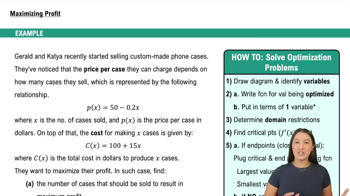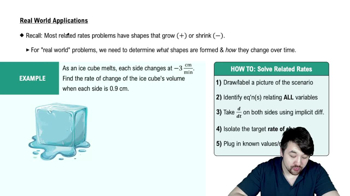Table of contents
- 0. Functions7h 52m
- Introduction to Functions16m
- Piecewise Functions10m
- Properties of Functions9m
- Common Functions1h 8m
- Transformations5m
- Combining Functions27m
- Exponent rules32m
- Exponential Functions28m
- Logarithmic Functions24m
- Properties of Logarithms34m
- Exponential & Logarithmic Equations35m
- Introduction to Trigonometric Functions38m
- Graphs of Trigonometric Functions44m
- Trigonometric Identities47m
- Inverse Trigonometric Functions48m
- 1. Limits and Continuity2h 2m
- 2. Intro to Derivatives1h 33m
- 3. Techniques of Differentiation3h 18m
- 4. Applications of Derivatives2h 38m
- 5. Graphical Applications of Derivatives6h 2m
- 6. Derivatives of Inverse, Exponential, & Logarithmic Functions2h 37m
- 7. Antiderivatives & Indefinite Integrals1h 26m
- 8. Definite Integrals4h 44m
- 9. Graphical Applications of Integrals2h 27m
- 10. Physics Applications of Integrals 2h 22m
4. Applications of Derivatives
Related Rates
Problem 3.6.31b
Textbook Question
Consider the following cost functions.
b. Determine the average cost and the marginal cost when x=a.
C(x) = − 0.01x²+40x+100, 0≤x≤1500, a=1000
 Verified step by step guidance
Verified step by step guidance1
To find the average cost, we need to divide the total cost function C(x) by the number of units x. The average cost function A(x) is given by A(x) = C(x)/x.
Substitute the given cost function C(x) = -0.01x² + 40x + 100 into the average cost formula: A(x) = (-0.01x² + 40x + 100)/x.
Simplify the expression for A(x) by dividing each term in the numerator by x: A(x) = -0.01x + 40 + 100/x.
To find the average cost at x = a = 1000, substitute x = 1000 into the simplified average cost function: A(1000) = -0.01(1000) + 40 + 100/1000.
The marginal cost is the derivative of the cost function C(x) with respect to x. Compute the derivative C'(x) = d/dx(-0.01x² + 40x + 100) and then evaluate C'(1000) to find the marginal cost at x = 1000.
 Verified video answer for a similar problem:
Verified video answer for a similar problem:This video solution was recommended by our tutors as helpful for the problem above
Video duration:
7mPlay a video:
Was this helpful?
Key Concepts
Here are the essential concepts you must grasp in order to answer the question correctly.
Cost Functions
A cost function represents the total cost incurred by a firm in producing a certain quantity of goods, denoted as C(x). In this case, the function C(x) = -0.01x² + 40x + 100 describes how costs change with varying levels of production (x). Understanding the structure of this function is essential for analyzing average and marginal costs.
Recommended video:

Properties of Functions
Average Cost
The average cost is calculated by dividing the total cost by the quantity produced, expressed as AC(x) = C(x)/x. This metric provides insight into the cost per unit of production, helping firms assess efficiency. For the given cost function, calculating the average cost at x = 1000 will reveal how much it costs, on average, to produce each unit at that production level.
Recommended video:

Average Value of a Function
Marginal Cost
Marginal cost refers to the additional cost incurred by producing one more unit of a good, mathematically represented as MC(x) = C'(x), where C'(x) is the derivative of the cost function. This concept is crucial for decision-making in production, as it helps firms determine the cost-effectiveness of increasing output. Evaluating the marginal cost at x = 1000 will indicate the cost impact of producing one additional unit at that level.
Recommended video:

Example 3: Maximizing Profit
Related Videos
Related Practice






